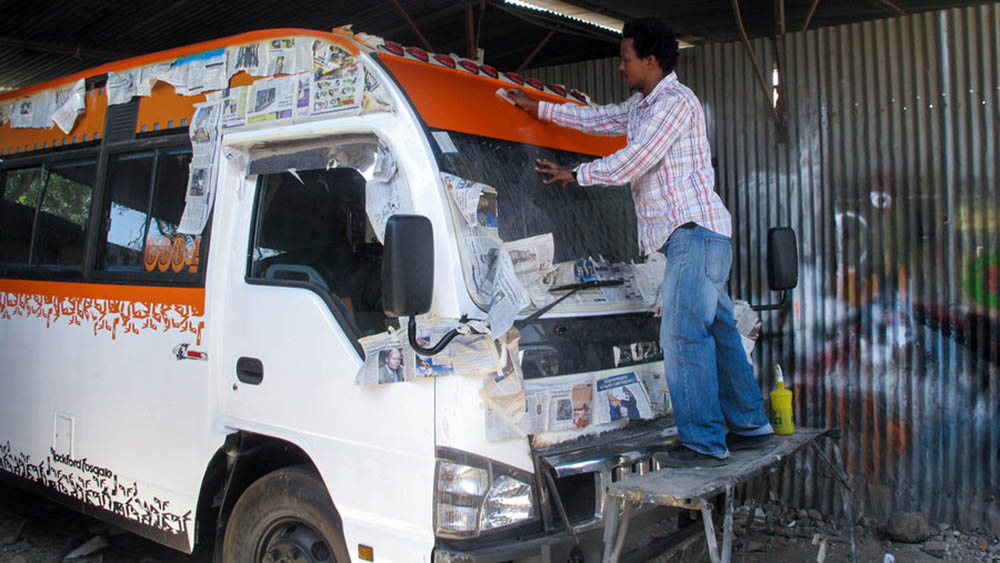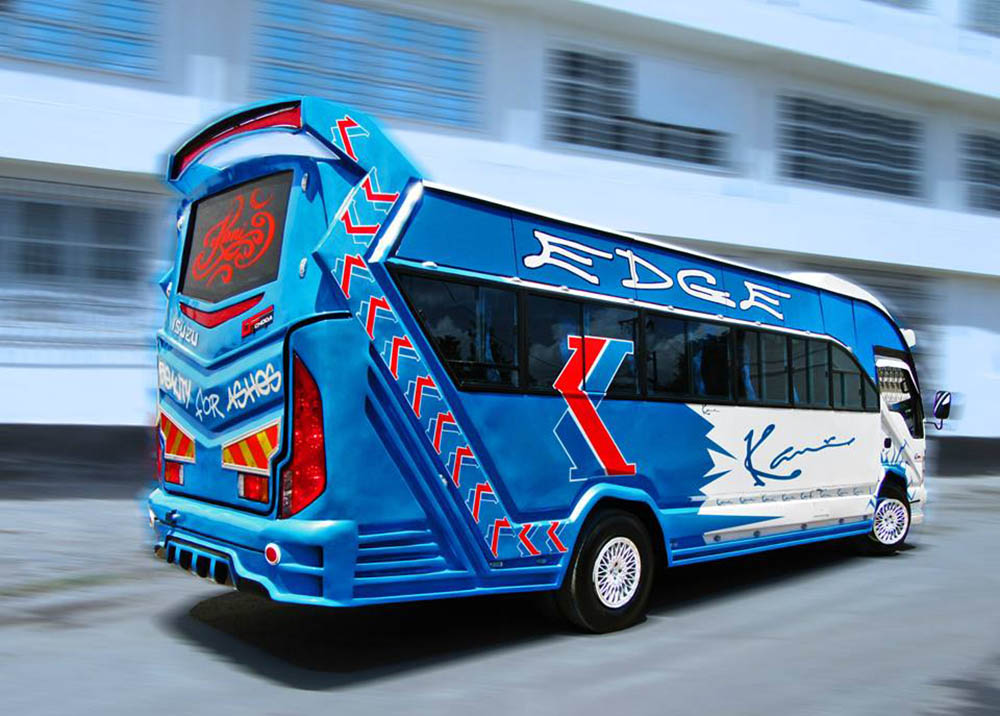London has red buses, New York has it’s taxi cabs, the Philippines has the Jeepneys, New Delhi auto rickshaws, Nairobi has its matatus.
 Image Source
Image Source
Matatu is slang for mini buses that are used as public transportation in Kenya. In Nairobi, public transportation is the norm for majority of the population and matatus play a critical role in providing city dwellers with transport.
A BRIEF HISTORY
Immediately after independence, public transportation was still underdeveloped. Only London’s Overseas Trading Company (OTC) operated a fleet of buses plying select routes. People would walk for miles and hike rides just to go to work or travel from one place to another.
This prompted the then President Jomo Kenyatta to commission the first matatus in Nairobi – a fleet of pickups and lorries. Wooden benches were installed in the vehicles dubbed, “Face me, I face you”. Owners even built tents on the trunk of the pickups to shelter passengers from harsh weather.
The renowned matatu culture then started taking shape in the 70s and blossomed its way into the 80s, during which different models of the Ford, Volkswagen s and Peugeot also acted as alternative means of transport.
 Face me matatus common in the 80’s
Face me matatus common in the 80’s
The 90s, seemed to be the pinnacle of the matatus and what came to be dubbed as matatu culture. Fast and furious while breaking all rules of the road with abandon, colorful graffiti mainly consisting of hip hop and reggae icons, blaring music from multiple speakers, hooting and honking all over the place while simultaneously collecting passengers. Matatus were also a haven for pick pockets, passengers would be packed like sardines literally, truancy was common especially in schools located in a routes served by the ‘illest’ matatus as students would skip school for continuous rides. Matatus and the consequent matatu culture was enthralling and chaotic to say the least.
However come early 2000s, a heavy blow was dealt to the ‘Matatu culture’ when the then transport minister came up with a raft of new rules governing the matatu industry. Matatu art (claimed to be vulgar and unruly), loud music was banned and all matatus were required to have one color with a yellow strip. Standing passengers were banned, the passenger capacity of minivans (commonly referred to as Nissans) was reduced from 18 passengers to 13. In addition, crews of matatus had to be vetted by police and receive a Certificate of Good Conduct before employment. Matatus were also required to install seat belts and speed governors.
Minivan 14 seater matatu
After resisting the rules which included a strike paralyzing public transport in the city for several days, most operators reluctantly adhered to the rules which while restoring sanity on the roads saw the decline of a vibrant culture.
Graffiti artists painting a matatu. Image Source
Late 2013 saw the current President lift the ban on matatu artwork recognizing it as a form of employment especially among the youth. The grafitti being a source of employment for scores of young Kenyans who cannot be absorbed by the formal job market.
Now matatu grafitti has reemerged stronger than ever. Also known as ‘manyanga’ or ‘nganya’, these matatus spare no expense in ensuring the comfort of their passengers.
Graffiti from pop culture, music icons and contemporary topics adorn matatus in a show of artistic prowess. The more colorful, the more famous it is and the more likely it is to attract passengers.
In a bid to outdo competition, some matatus are fitted with wi-fi connectivity to lure passengers. They are very popular, especially with the urban Kenyan youth who own smartphones and are in constant contact with their peers on social networks.
Not forgetting the loud music. Custom-made sound systems fitted discretely in the interior, with plasma screens at the front for all to enjoy high definition music videos. At night, LED lights are switched on, turning the van into a sort of mobile discotheque.If it is not loud music you are being subjected to, you are likely to join other passengers in listening to vibrant and hilarious phone-in discussions on FM stations in the morning.
Image Source Matwana
.
The Interiors. No expense is spared
Matatus operate without timetables, they will park at the bus stage calling for passengers and only leave when they are full. The matatus that fill up the quickest are the fashionable ones with the brightest artwork, the hippest conductors and of course the latest music system. Music attracts more customers, they fill up quicker and get to their destination sooner. Loud music and free Wi-Fi are the bare minimum requirements for a matatu’s entry into the league of greats.
Enough with the talking, below is an eye-catching compilation of the most ‘pimped’ up matatus plying Kenyan roads.
Image Source
.
Image Source
.
Image Source
.
Image Source
.
Image Source
.
Image Source
.
Image Source
.
Image Source
.
Image Source
.
Image Source
.
Image Source
.
Image Source
.
Image Source
.
Image Source
.
Image Source
.
Image Source
.
Image Source
.
Image Source
.
Image Source Matatu World
.
Image Source Matwana
.
Image Source
.
Image Source
Because of the competition, it is almost impossible for a single matatu to remain the ‘hot cake’ for more than three months. There will always be another one the way.
The matatu remains an indispensable part of Kenyan culture that offers a necessary service and a thrilling roller coaster experience.
Ultimately, whether you love or hate Nairobi matatus, there is quite nothing like them!
Have you been to Nairobi and used a matatu to get to your destination? What was your experience like?




































8 Comments
I love the matatus. But I love your photography even more. Girl you are good.
Wow! I haven’t been to Nairobi and have never heard or seen the matatu. All I can say is, wow! Awesome collection of photos by the way; really makes me want to go see them in real life. #weekendtravelinspiration
Great stuff! We call them “face me, l face you to” 🙂 . Boy, l wish they would do something like this in Naija, then they might take more care of people in their effort to take care of their vehicles, they wouldn’t want to get in an accident and lose their investment 🙂 .
I’m glad to see that matatus made a comeback after all of the red tape. I’ll definitely have to ride in one whenever I make it to Nairobi.
[…] I spotted a really cool Prince-themed matatu in Nairobi! Matatus (minibuses) are very colourful and often have themes (rappers, sports, brands, etc). There’s a lot of creativity involved! It’s also a recent change because previously, loud music and bright colours were banned on m… […]
I’m in love with those matatus…they have very attractive colors
They are the best because they create jobs for the youth
[…] Images Sourced from Here […]